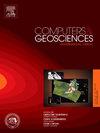Prediction of ultrabasic rocks by support vector machine based on airborne magnetic and radioactivity data
IF 4.4
2区 地球科学
Q1 COMPUTER SCIENCE, INTERDISCIPLINARY APPLICATIONS
引用次数: 0
Abstract
Copper-nickel (Cu-Ni) deposits are short-supply strategic mineral resources. Ultrabasic rocks are the important ore-forming geological bodies of Cu-Ni deposits. The accurate identification of ultrabasic rocks is important for predicting Cu-Ni deposits. With the high-level prospecting, the outcropped ultrabasic rocks are mostly discovered, while the concealed ones are difficult to detect by geological mapping. Geophysical data contains deep information that is important in concealed ultrabasic rock prospecting. Based on the physical properties (high magnetic susceptibility and low radioactivity), we use large-range, high-precision airborne magnetic and radioactive data to predict undiscovered ultrabasic rocks. With the development of artificial intelligence technology, support vector machines (SVM) have the advantage of strong classification ability and are suitable for small samples. Because of the influence of several parameters, it is difficult to get a prediction result with high geological interpretability. Therefore, genetic algorithms (GA) with global optimization are used in this study to obtain better SVM parameters. The geological factors are first proposed to describe ultrabasic rock characteristics and added into the fitness functions of GA to improve accuracy and geological interpretability. The geological factors consist of shape (Fshape), area (Farea), and scatter (Fsactter). Consequently, support vector machines optimized by genetic algorithms (GASVM) are applied to predict ultrabasic rocks in the Qilian orogen. The airborne magnetic and radioactive data consider different geophysical properties and reveal geological characteristics of ultrabasic rocks from deep to shallow. The results are better than the prediction by a single dataset. In addition, we test three standardization methods, the rising ridge distribution standardization method could effectively and efficiently improve the prediction accuracy. The perdition accuracies are higher than 85% compared with the known ultrabasic rocks. The prediction ranges are concentrated in less than 10% of the whole area. Two ultrabasic rocks are first predicted in this study which is confirmed by field investigation. Meanwhile, concealed ultrabasic rocks are predicted in the southeast of the study area, which are not shown on the geological map. The results can provide general and reliable distributions of ultrabasic rock and rapidly delineate the favorite area for Cu-Ni deposit prospecting.
基于航空磁、放射性数据的支持向量机超基性岩预测
铜镍矿床是紧缺的战略性矿产资源。超基性岩是铜镍矿床重要的成矿地质体。超基性岩的准确识别对预测铜镍矿床具有重要意义。随着找矿水平的提高,出露的超基性岩多被发现,而隐伏的超基性岩则难以通过地质填图发现。地球物理资料包含深部信息,对隐伏超基性岩找矿具有重要意义。根据超基性岩石的物理性质(高磁化率、低放射性),利用大范围、高精度的航空磁性和放射性数据对未发现的超基性岩石进行预测。随着人工智能技术的发展,支持向量机(SVM)具有分类能力强、适用于小样本的优势。由于多个参数的影响,很难得到具有较高地质可解释性的预测结果。因此,本研究采用全局寻优的遗传算法(GA)来获得更好的支持向量机参数。首次提出用地质因子描述超基性岩石特征,并将其加入遗传算法的适应度函数中,提高遗传算法的精度和地质可解释性。地质因素包括形状(Fshape)、面积(Farea)和散点(Fsactter)。为此,将遗传算法优化的支持向量机(GASVM)应用于祁连造山带超基性岩预测。航空磁、放射性资料考虑了不同的地球物理性质,揭示了超基性岩从深到浅的地质特征。结果优于单一数据集的预测结果。另外,对三种标准化方法进行了试验,表明上升脊分布标准化方法能有效提高预报精度。与已知超基性岩相比较,预测精度在85%以上。预测范围集中在整个地区的10%以下。本研究首次预测了2种超基性岩,并通过实地考察得到了证实。同时,预测研究区东南部存在隐伏超基性岩,这些超基性岩在地质图上未显示。研究结果可提供一般可靠的超基性岩分布,快速圈定铜镍矿床找矿有利区。
本文章由计算机程序翻译,如有差异,请以英文原文为准。
求助全文
约1分钟内获得全文
求助全文
来源期刊

Computers & Geosciences
地学-地球科学综合
CiteScore
9.30
自引率
6.80%
发文量
164
审稿时长
3.4 months
期刊介绍:
Computers & Geosciences publishes high impact, original research at the interface between Computer Sciences and Geosciences. Publications should apply modern computer science paradigms, whether computational or informatics-based, to address problems in the geosciences.
 求助内容:
求助内容: 应助结果提醒方式:
应助结果提醒方式:


